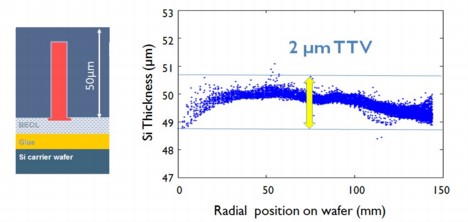Home > Press > Novel 3D integration process flow: backside ‘soft’ via reveal
 |
| Figure 3D integration_1: Wafers are thinned down to 50µm thickness, with a total thickness variation of less than 2µm. |
Abstract:
Imec presents a via-middle through-Si-via (TSV) approach to 3D stacking. This method is new to industry as it allows to ‘reveal' TSV contacts by using a Si-etch process. The process further allows thinning down the wafers to 50µm with a total thickness variation of less than 2µm.
Novel 3D integration process flow: backside ‘soft’ via reveal
Leuven, Belgium | Posted on March 15th, 2012In the new 3D integration flow, a TSV contact is buried in the wafer during front-side processing. After completion of the wafer processing, the wafer is thinned and the bottom side of the TSV contacts are ‘revealed' in order to contact to a next layer of a 3D stack.
This process is novel to IC manufacturing and has to be performed with great care, in order not to damage the devices. In the past year, great progress has been made with respect to the wafer-support system for handling 300mm wafers, thinned down to 50µm thickness. A total thickness variation (TTV) of the thinned wafer of less than 2µm has been achieved. Key step in this process is the bonding of the device wafer to a carrier wafer, prior to wafer thinning, by using a temporary adhesive. This material is stable during the subsequent process steps, but still allows for room temperature debonding of the thinned wafer upon completion of backside processing.
After wafer thinning, the backsides of the TSVs are successfully ‘revealed' using a Si-etch process. Both wet and dry processes can be used. Chemical mechanical polishing (CMP) of the Cu/Si surface is not used as it results in a high risk of contamination and has a high cost-of-ownership. An effective via reveal process has been obtained using wet etching, exposing the TSVs uniformly on the wafer backside. In this stage, the TSV nails are still protected by their barrier and liner layers.
The next step in the backside process consists of applying a backside passivation layer (this avoids Cu diffusion in the thin Si wafer) and selective opening of the liner layers on the TSV. This is achieved using a maskless, self-aligned dry etch-process.
After this ‘soft' via reveal process, further interconnect layers and bump interconnects can be processed on the wafer backside. The process is then completed by debonding the thin wafer from the carrier wafer and transferring the thin wafer to a dicing tape. This step can now be performed at room temperature. This process flow was successfully applied to a 300mm diameter wafer with active high-k/metal gate CMOS circuits.
####
For more information, please click here
Contacts:
Barbara Kalkis
Maestro Marketing & PR
Copyright © IMEC
If you have a comment, please Contact us.Issuers of news releases, not 7th Wave, Inc. or Nanotechnology Now, are solely responsible for the accuracy of the content.
| Related News Press |
News and information
![]() Researchers develop molecular qubits that communicate at telecom frequencies October 3rd, 2025
Researchers develop molecular qubits that communicate at telecom frequencies October 3rd, 2025
![]() Next-generation quantum communication October 3rd, 2025
Next-generation quantum communication October 3rd, 2025
![]() "Nanoreactor" cage uses visible light for catalytic and ultra-selective cross-cycloadditions October 3rd, 2025
"Nanoreactor" cage uses visible light for catalytic and ultra-selective cross-cycloadditions October 3rd, 2025
Chip Technology
![]() Lab to industry: InSe wafer-scale breakthrough for future electronics August 8th, 2025
Lab to industry: InSe wafer-scale breakthrough for future electronics August 8th, 2025
![]() A 1960s idea inspires NBI researchers to study hitherto inaccessible quantum states June 6th, 2025
A 1960s idea inspires NBI researchers to study hitherto inaccessible quantum states June 6th, 2025
![]() Programmable electron-induced color router array May 14th, 2025
Programmable electron-induced color router array May 14th, 2025
Announcements
![]() Rice membrane extracts lithium from brines with greater speed, less waste October 3rd, 2025
Rice membrane extracts lithium from brines with greater speed, less waste October 3rd, 2025
![]() Researchers develop molecular qubits that communicate at telecom frequencies October 3rd, 2025
Researchers develop molecular qubits that communicate at telecom frequencies October 3rd, 2025
![]() Next-generation quantum communication October 3rd, 2025
Next-generation quantum communication October 3rd, 2025
![]() "Nanoreactor" cage uses visible light for catalytic and ultra-selective cross-cycloadditions October 3rd, 2025
"Nanoreactor" cage uses visible light for catalytic and ultra-selective cross-cycloadditions October 3rd, 2025
|
|
||
|
|
||
| The latest news from around the world, FREE | ||
|
|
||
|
|
||
| Premium Products | ||
|
|
||
|
Only the news you want to read!
Learn More |
||
|
|
||
|
Full-service, expert consulting
Learn More |
||
|
|
||








